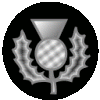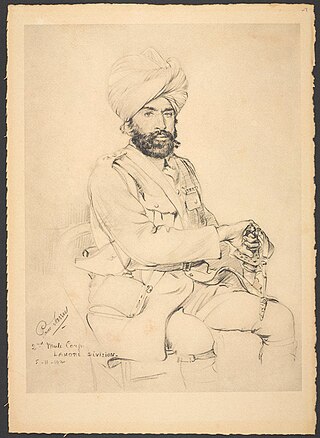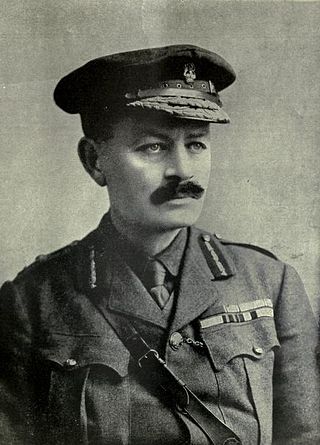
The 9th (Scottish) Division, was an infantry division of the British Army during the First World War, one of the Kitchener's Army divisions raised from volunteers by Lord Kitchener to serve on the Western Front during the First World War.

The 4th Infantry Division was a regular infantry division of the British Army with a very long history, seeing active service in the Peninsular War and Waterloo Campaign, the Crimean and Boer Wars and both World Wars. It was disbanded after the Second World War and reformed in the 1950s as an armoured formation before being disbanded and reformed again and finally disbanded on 1 January 2012.

The 21st Division was an infantry division of the British Army during World War I, raised in September 1914 by men volunteering for Lord Kitchener's New Armies. The division moved to France in September 1915 and served on the Western Front for the duration of the First World War. The divisional insignia was the "triple-seven".

The 5th Indian Infantry Division was an infantry division of the Indian Army during World War II that fought in several theatres of war and was nicknamed the "Ball of Fire". It was one of the few Allied divisions to fight against three different armies - the Italian, German and Japanese armies.

The Home Counties Division was an infantry division of the Territorial Force, part of the British Army, that was raised in 1908. As the name suggests, the division recruited in the Home Counties, particularly Kent, Middlesex, Surrey and Sussex.

The 19th Indian Infantry Division was an infantry division of the Indian Army during World War II, and played a prominent part in the final part of the Burma Campaign.

The 14th Indian Infantry Division was an infantry division of the Indian Army during World War II. It fought in the Arakan Campaign 1942–43, and was subsequently converted into a Training Division, providing drafts of replacements for units of the Fourteenth Army during the Burma Campaign.

The 23rd Indian Infantry Division was an infantry division of the Indian Army during World War II. It fought in the Burma Campaign. It was then reformed as a division of the independent Indian Army in 1959.

The 81st Division was formed under British control during the Second World War. It took part in the Burma Campaign.
The 15th Indian Division was an infantry division of the British Indian Army that saw active service in the First World War. It served in the Mesopotamian Campaign on the Euphrates Front throughout its existence. It did not serve in the Second World War, but was reformed at Dehradun in 1964 as part of the post-independence Indian Army.
The 4th (Quetta) Division was an infantry division of the British Indian Army. It was formed by General Kitchener while he was Commander-in-chief of India. During World War I the division remained in India. Its composition was:

The 7th (Meerut) Division was an infantry division of the Indian Army and before 1895, the Bengal Army, that saw active service during World War I.

The 3rd (Lahore) Division was an infantry division of the Indian Army and before 1895, the Bengal Army, first organised in 1852. It saw service during World War I as part of the Indian Corps in France before being moved to the Middle East where it fought against troops of the Ottoman Empire.
The 6th (Poona) Division was a division of the British Indian Army. It was formed in 1903, following the Kitchener reforms of the Indian Army.
The 8th (Lucknow) Division was a formation of the British Indian Army's Northern Army that was first formed as a result of the Kitchener reforms of the Indian Army in 1903. The Division remained in India on internal security duties during World War I, though the 8th (Lucknow) Cavalry Brigade was transferred to the 1st Indian Cavalry Division and served in France on the Western Front, and the 22nd Lucknow Infantry Brigade served as part of the 11th Indian Division in Egypt.
The 5th (Mhow) Division was a regular division of the British Indian Army and part of the Southern Army which was formed in 1903 after Lord Kitchener was appointed Commander-in-Chief, India between 1902 and 1909. He instituted large-scale reforms, including merging the three armies of the Presidencies into a unified force and forming higher level formations, eight army divisions, and brigading Indian and British units. Following Kitchener's reforms, the British Indian Army was "the force recruited locally and permanently based in India, together with its expatriate British officers."
The 12th Indian Division was formed in March 1915 from units of the British Indian Army. It formed part of the Tigris Corps, for service during the Mesopotamia Campaign of World War I. The Division arrived in Mesopotamia in April 1915 and remained there until it was broken up in March 1916. The Division's brigades remained in Mesopotamia as independent formations until forming part of the 15th Indian Division in May 1916. During its short existence it fought in a number of actions including the Battle of Shaiba between April 12–14, 1915, the Battle of Khafajiya between May 14–16, 1915, the Battle of Nasiriya between July 5, 13-14, 24 1915, where 400 British and Indian soldiers were killed in the battle and up to 2,000 Turkish Soldiers. The Occupation of Nasiriya and the affair at Butanuja, January 14, 1916.
The 14th Indian Division was formed during World War I, for service in the Mesopotamian Campaign. It was composed of battalions of the Regular British Army, the British Territorial Force and the British Indian Army.
The Rawalpindi Parade 1905 was a parade by the British Indian Army held in Rawalpindi on 8 December 1905 to honour the Prince and Princess of Wales. The troops were under the Command of Horatio Herbert, Viscount Kitchener of Khartoum, G.C.B., O.M., G.C.M.G., Commander-in-Chief India. The Royal party arrived at the parade ground escorted by a Field Officer's escort of 1st Skinner's Horse. They then received a Royal salute and inspected the troops, accompanied by the Commander-in-chief. On conclusion of the inspection, the troops on parade marched past in the following order.

The Force in Egypt was a British Army formation established in August 1914 to administer garrisoning armed forces in Egypt at the beginning of the First World War. The force had the objective of protecting the Suez Canal and was originally commanded by Major General Julian Byng, but he was replaced by General J. Maxwell, who took command on 8 September 1914. Initially, the main threat to the Suez came from Germany and throughout the early months several of the force's elements were sent to Europe to take part in the fighting on the Western Front. On 5 November 1914, Britain and France declared war on the Ottoman Empire, after which the Force in Egypt faced a direct threat from Ottoman forces, which was realised in February 1915 with a raid on the Suez Canal. This threat remained until 1916 when the British forces went on the offensive.











